October 2003
Bigger screens, more resolution, more multimedia for PPCs
With Palm devices catching up (and in some instances passing) Pocket PCs, Microsoft revealed some much needed advancements to Windows Mobile at this year's Professional Developers Conference. There will be 480 x 640 screen support for Pocket PC and 240 x 320 for Smartphones. The new Toshiba e800, of course, already supports 480 x 640, but only for specially written apps. Microsoft will also make DirectX multimedia APIs available to Windows Mobile, thus adding significantly more powerful multimedia support, including 3D gaming where Palm (via Tapwave's Zodiac and others) is making inroads, and such phone-based gaming consoles as Nokia's nGage. In conjunction with Intel's supposed inclusion of MMX technology into the next generation of XScale, we may soon see handhelds that can not only hold their own in MP3 as is the case now, but also in video performance and gaming. -- Posted Wednesday, October 29, 2003
HTC introduces second generation Pocket PC Phone
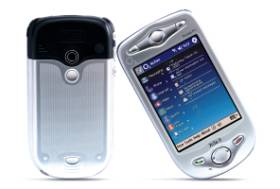 Digitimes reports that High tech Computer of Taiwan has started shipping a second generation tri-band GPRS Pocket PC Phone called Xda II to European phone service provider O2. The very handsome device has a 400MHz PXA255 processor, 128MB of RAM, a 640x480 digital camera, and Bluetooth. Overall, the device looks like a more advanced successor to the original StrongARM-based HTC Pocket PC Phone (see detailed review in Pen Computing Magazine) which was/is marketed in the US by T-Mobile. Reminiscent of Sony Ericsson's immensely popular T610/616 phone, the camera appears to be innocuously mounted in the back of the device,thus enabling "stealth photography." With a Windows Mobile 2003 version of the Phone Edition imminent, this should be an interesting device indeed. -- Posted Monday, October 27, 2003
Digitimes reports that High tech Computer of Taiwan has started shipping a second generation tri-band GPRS Pocket PC Phone called Xda II to European phone service provider O2. The very handsome device has a 400MHz PXA255 processor, 128MB of RAM, a 640x480 digital camera, and Bluetooth. Overall, the device looks like a more advanced successor to the original StrongARM-based HTC Pocket PC Phone (see detailed review in Pen Computing Magazine) which was/is marketed in the US by T-Mobile. Reminiscent of Sony Ericsson's immensely popular T610/616 phone, the camera appears to be innocuously mounted in the back of the device,thus enabling "stealth photography." With a Windows Mobile 2003 version of the Phone Edition imminent, this should be an interesting device indeed. -- Posted Monday, October 27, 2003
Car-mounted MP3 player controlled by Palm device
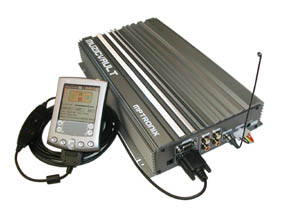 MPtronix has a car-mountable MP3 player that they call MuzicVault. Songs are stored on a hard drive and playback is managed with a Palm (from III, V and up) or Sony-branded handheld, currently with a wired connection. A Bluetooth model will be coming soon. On the wired model, the PDA can be charged while connected to the MuzicVault. It can connect with the car stereo in one of three ways: via line-in, fiber optic, or the built-in FM transmitter. We've seen spotty performance with other such FM transmitters, but MPtronics assures us that this transmitter is more powerful, such that it could send signal to several cars parked nearby. Songs are loaded onto the device via a USB 2.0 cable. The unit appears on PC, Mac, and Linux computers as a hard drive. Files install easily via drag and drop with a 480Mbps maximum transfer speed. MP3 quality can be between 8 and 320 Kbps. Using Bluetooth and FM transmission, it's a simple 3 wire install: power, ground, and ignition. Its nice aluminum casing is available in cherry red or gray. Other potential uses, according to the company, are restaurants and bars, or anywhere shuffled or playlist music would be beneficial. Currently available hard drive sizes are 20, 40, 60, and 80GB. Prices range from US$399 to US$599. http://www.mptronix.com -- Posted Thursday, October 9, 2003
MPtronix has a car-mountable MP3 player that they call MuzicVault. Songs are stored on a hard drive and playback is managed with a Palm (from III, V and up) or Sony-branded handheld, currently with a wired connection. A Bluetooth model will be coming soon. On the wired model, the PDA can be charged while connected to the MuzicVault. It can connect with the car stereo in one of three ways: via line-in, fiber optic, or the built-in FM transmitter. We've seen spotty performance with other such FM transmitters, but MPtronics assures us that this transmitter is more powerful, such that it could send signal to several cars parked nearby. Songs are loaded onto the device via a USB 2.0 cable. The unit appears on PC, Mac, and Linux computers as a hard drive. Files install easily via drag and drop with a 480Mbps maximum transfer speed. MP3 quality can be between 8 and 320 Kbps. Using Bluetooth and FM transmission, it's a simple 3 wire install: power, ground, and ignition. Its nice aluminum casing is available in cherry red or gray. Other potential uses, according to the company, are restaurants and bars, or anywhere shuffled or playlist music would be beneficial. Currently available hard drive sizes are 20, 40, 60, and 80GB. Prices range from US$399 to US$599. http://www.mptronix.com -- Posted Thursday, October 9, 2003
Sculley expreses regrets about Newton
Former Apple CEO John Sculley, who is now a partner in the Sculley Brothers venture capital firm, was recently interviewed by Dawn Kawamoto for a CNET article entitled "Riding the next technology wave." Sculley portrayed WiFi as a huge "landscape for innovation and business creation." Sculley also reminisced about his days at Apple and lost opportunities. Hypercard, he saw as a huge missed opportunity""to go take our user interface culture, and our know-how, and applied it to the Internet." And "Newton could have been one of Apple's most profitable investments ever," Sculley said and explained how licensing the chip design and software concepts to third parties to maintain the early lead in the PDA industry that eventually became dominated by Palm (where a lot of former Apple/Newton talent worked), heavily challenged by Microsoft itself. A missed opportunity indeed. And interesting how the very handwriting recognizer used in the Newton eventually made its way into Pocket PCs and even the Tablet PC. -- Posted Friday, October 3, 2003
Before the split and merge, palmOne takes to ARMs
For only the second time, Palm--I mean palmOne--announced three handhelds at once. They range from the fast, high end wireless US$400 color model to the US$100 monochrome unit; all of the units, however, sport an ARM processor of one speed or another.
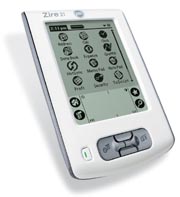 Starting with the Zire 21, the low end now has greater speed than any 160 x 160 monochrome Palm has ever had, due to its 126MHz TI OMAP processor. It also has 7.2MB RAM (on an 8MB chip). It runs PalmSource's latest OS, version 5.2.1. Externally, the Zire 21 is the same as the original Zire. Still no cradle, as the power and USB jacks are still on top. It's considerably more power in a light and uncomplicated package. The Zire 21 replaces the original Zire at the US$99 price point.
Starting with the Zire 21, the low end now has greater speed than any 160 x 160 monochrome Palm has ever had, due to its 126MHz TI OMAP processor. It also has 7.2MB RAM (on an 8MB chip). It runs PalmSource's latest OS, version 5.2.1. Externally, the Zire 21 is the same as the original Zire. Still no cradle, as the power and USB jacks are still on top. It's considerably more power in a light and uncomplicated package. The Zire 21 replaces the original Zire at the US$99 price point.
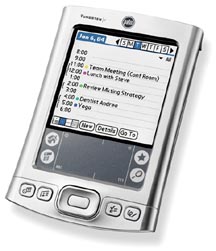
Next is the new Tungsten E, a new design that appears to be aimed at fans of the legendary Palm V. It's simpler than the Tungsten T and C lines, in that it lacks wireless, and has no speaker. It also connects like the low-end Zires, which means there is no cradle available. Unlike the Zire and Zire 21, the two ports are at the bottom of the unit. Universal connector accessories and chargers, as a result, will not work with the E. It does have a vibrant backlit 320 x 320 64K color TFT. It uses a 126MHz OMAP 311 processor. Its case is shiny metallic silver, and is a little wider than the other two introductions. It's a half inch thick, Palm's thinnest since the Palm V. A flip cover is included, as is an SD/SDIO slot. The five way navigator is also present. 28.8 of 32MB are available for programs, and quite a few are bundled with the device. Though there is no speaker for audio playback, there is a 3.5mm audio jack for headphones, and the RealOne player is bundled for playback of MP3s from an SD card. This will be a good basic Palm that does just what most users will want for a price that's more realistic as an organizer, US$199.
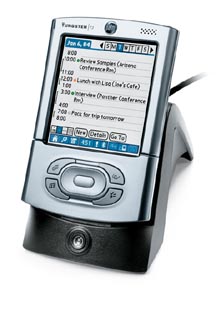 Finally, what this reviewer has been waiting for: a Tungsten T with some teeth. The Tungsten T3. If you waited on buying that T2, rest assured you did the right thing. This was worth the wait. The T line is the power user's Palm, and all that power has more than doubled. Gather round, now. We're looking at a 400MHz Intel XScale processor with 52MB available on the 64MB RAM chip. But that' s not all, because the screen is 50% bigger, offering twice the number of pixels that a Pocket PC does, at 320 x 480. The T's unique expansion mechanism reveals this extra 50% with a pull, and the Graffiti area is now virtual, meaning it can be moved out of the way to give programs more screen area.
Finally, what this reviewer has been waiting for: a Tungsten T with some teeth. The Tungsten T3. If you waited on buying that T2, rest assured you did the right thing. This was worth the wait. The T line is the power user's Palm, and all that power has more than doubled. Gather round, now. We're looking at a 400MHz Intel XScale processor with 52MB available on the 64MB RAM chip. But that' s not all, because the screen is 50% bigger, offering twice the number of pixels that a Pocket PC does, at 320 x 480. The T's unique expansion mechanism reveals this extra 50% with a pull, and the Graffiti area is now virtual, meaning it can be moved out of the way to give programs more screen area.
There are many improvements in this device, including an enhanced Date Book, Contacts (yes, they changed the name from Address Book), and To Do List (these enhancements are also on the E); and a new status bar along the bottom. The status bar is always present, offering Home, Find, Menu, Clock, Alert, Bluetooth, Onscreen writing switch, Rotate switch, and Hide Graffiti area buttons, whether the slider is open or closed. What's that? I thought you might notice that: you can indeed rotate the screen. Screen rotations are fast, allowing a better view of text, web pages, photographs, videos, and spreadsheets. The Kinoma Player, Documents to Go, and other applications have been enhanced to take advantage of the new display spec. Programs written to conform to the upcoming OS6 standards will also comply, according to palmOne's Anthony Armenta.

Other enhancements include changeable Graffiti area icons (just tap and hold to bring up a menu of eligible applications). Or tap and hold on the small house icon to bring up a list of the last six applications used. These are both permutations of Pocket PC ideas, but in the case of the latter list function, these six programs are not left running in the background like they are on the PPC.
The body is anodized aluminum and the unit flares slightly top and bottom, looking a little more like the m500s that preceded the T. The slider is about as tight as was the T2, but the bottom body is a little longer, making the whole unit seem considerably longer when open; in reality it's only about an eighth of an inch. It's also a little slimmer than the original Tungsten T design. A leather flip cover that attaches at the back and flips over the top is included. I love flip covers. There's a door now covering the SD slot, a smart improvement that's indicative of how much finer this unit is than the already excellent T. "We did a lot of work this year," said Armenta. He's not kidding. We'll have to wait for a full review to see all the details.
The T3 is fast. Satisfyingly fast. It feels like a Palm from the future, not one debuting just a year from the original Tungsten T. I've only just begun exploring the new applications, but they offer some improvements that have been long overdue, others that are surprisingly novel. Most important is the ability to support multiple addresses in the Contacts list, meaning better sync with Outlook. Categories have also been introduced to the Date Book application, including colored dots next to each item so users can differentiate them with a glance. Date Book databases can even be beamed to other users, allowing husband and wife or coworkers to share schedules, turning them on and off at will.
The T3 is a significant upgrade, offering the ultimate feature-set for Palm OS fans. The T3 is the tightest, smartest, most comprehensive improvement in Palm design in Palm OS history. This device is easily worth the US$399 price tag. Enthusiasts rejoice. http://www.palmone.com
-- Posted Wednesday, October 1, 2003
 Digitimes reports that High tech Computer of Taiwan has started shipping a second generation tri-band GPRS Pocket PC Phone called Xda II to European phone service provider O2. The very handsome device has a 400MHz PXA255 processor, 128MB of RAM, a 640x480 digital camera, and Bluetooth. Overall, the device looks like a more advanced successor to the original StrongARM-based HTC Pocket PC Phone (see detailed review in Pen Computing Magazine) which was/is marketed in the US by T-Mobile. Reminiscent of Sony Ericsson's immensely popular T610/616 phone, the camera appears to be innocuously mounted in the back of the device,thus enabling "stealth photography." With a Windows Mobile 2003 version of the Phone Edition imminent, this should be an interesting device indeed. -- Posted Monday, October 27, 2003
Digitimes reports that High tech Computer of Taiwan has started shipping a second generation tri-band GPRS Pocket PC Phone called Xda II to European phone service provider O2. The very handsome device has a 400MHz PXA255 processor, 128MB of RAM, a 640x480 digital camera, and Bluetooth. Overall, the device looks like a more advanced successor to the original StrongARM-based HTC Pocket PC Phone (see detailed review in Pen Computing Magazine) which was/is marketed in the US by T-Mobile. Reminiscent of Sony Ericsson's immensely popular T610/616 phone, the camera appears to be innocuously mounted in the back of the device,thus enabling "stealth photography." With a Windows Mobile 2003 version of the Phone Edition imminent, this should be an interesting device indeed. -- Posted Monday, October 27, 2003 MPtronix has a car-mountable MP3 player that they call MuzicVault. Songs are stored on a hard drive and playback is managed with a Palm (from III, V and up) or Sony-branded handheld, currently with a wired connection. A Bluetooth model will be coming soon. On the wired model, the PDA can be charged while connected to the MuzicVault. It can connect with the car stereo in one of three ways: via line-in, fiber optic, or the built-in FM transmitter. We've seen spotty performance with other such FM transmitters, but MPtronics assures us that this transmitter is more powerful, such that it could send signal to several cars parked nearby. Songs are loaded onto the device via a USB 2.0 cable. The unit appears on PC, Mac, and Linux computers as a hard drive. Files install easily via drag and drop with a 480Mbps maximum transfer speed. MP3 quality can be between 8 and 320 Kbps. Using Bluetooth and FM transmission, it's a simple 3 wire install: power, ground, and ignition. Its nice aluminum casing is available in cherry red or gray. Other potential uses, according to the company, are restaurants and bars, or anywhere shuffled or playlist music would be beneficial. Currently available hard drive sizes are 20, 40, 60, and 80GB. Prices range from US$399 to US$599.
MPtronix has a car-mountable MP3 player that they call MuzicVault. Songs are stored on a hard drive and playback is managed with a Palm (from III, V and up) or Sony-branded handheld, currently with a wired connection. A Bluetooth model will be coming soon. On the wired model, the PDA can be charged while connected to the MuzicVault. It can connect with the car stereo in one of three ways: via line-in, fiber optic, or the built-in FM transmitter. We've seen spotty performance with other such FM transmitters, but MPtronics assures us that this transmitter is more powerful, such that it could send signal to several cars parked nearby. Songs are loaded onto the device via a USB 2.0 cable. The unit appears on PC, Mac, and Linux computers as a hard drive. Files install easily via drag and drop with a 480Mbps maximum transfer speed. MP3 quality can be between 8 and 320 Kbps. Using Bluetooth and FM transmission, it's a simple 3 wire install: power, ground, and ignition. Its nice aluminum casing is available in cherry red or gray. Other potential uses, according to the company, are restaurants and bars, or anywhere shuffled or playlist music would be beneficial. Currently available hard drive sizes are 20, 40, 60, and 80GB. Prices range from US$399 to US$599.  Starting with the Zire 21, the low end now has greater speed than any 160 x 160 monochrome Palm has ever had, due to its 126MHz TI OMAP processor. It also has 7.2MB RAM (on an 8MB chip). It runs PalmSource's latest OS, version 5.2.1. Externally, the Zire 21 is the same as the original Zire. Still no cradle, as the power and USB jacks are still on top. It's considerably more power in a light and uncomplicated package. The Zire 21 replaces the original Zire at the US$99 price point.
Starting with the Zire 21, the low end now has greater speed than any 160 x 160 monochrome Palm has ever had, due to its 126MHz TI OMAP processor. It also has 7.2MB RAM (on an 8MB chip). It runs PalmSource's latest OS, version 5.2.1. Externally, the Zire 21 is the same as the original Zire. Still no cradle, as the power and USB jacks are still on top. It's considerably more power in a light and uncomplicated package. The Zire 21 replaces the original Zire at the US$99 price point. 
 Finally, what this reviewer has been waiting for: a Tungsten T with some teeth. The Tungsten T3. If you waited on buying that T2, rest assured you did the right thing. This was worth the wait. The T line is the power user's Palm, and all that power has more than doubled. Gather round, now. We're looking at a 400MHz Intel XScale processor with 52MB available on the 64MB RAM chip. But that' s not all, because the screen is 50% bigger, offering twice the number of pixels that a Pocket PC does, at 320 x 480. The T's unique expansion mechanism reveals this extra 50% with a pull, and the Graffiti area is now virtual, meaning it can be moved out of the way to give programs more screen area.
Finally, what this reviewer has been waiting for: a Tungsten T with some teeth. The Tungsten T3. If you waited on buying that T2, rest assured you did the right thing. This was worth the wait. The T line is the power user's Palm, and all that power has more than doubled. Gather round, now. We're looking at a 400MHz Intel XScale processor with 52MB available on the 64MB RAM chip. But that' s not all, because the screen is 50% bigger, offering twice the number of pixels that a Pocket PC does, at 320 x 480. The T's unique expansion mechanism reveals this extra 50% with a pull, and the Graffiti area is now virtual, meaning it can be moved out of the way to give programs more screen area. 